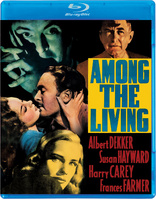Among the Living Blu-ray Movie
HomeAmong the Living Blu-ray Movie 
Kino Lorber | 1941 | 69 min | Not rated | Nov 16, 2021Movie rating
6.9 | / 10 |
Blu-ray rating
| Users | 0.0 | |
| Reviewer | 3.5 | |
| Overall | 3.5 |
Overview
Among the Living (1941)
A mentally unstable man, who has been kept in isolation for years, escapes and causes trouble for his identical twin brother.
Starring: Albert Dekker, Susan Hayward, Harry Carey, Frances Farmer, Gordon Jones (I)Director: Stuart Heisler
| Film-Noir | Uncertain |
| Thriller | Uncertain |
| Drama | Uncertain |
| Mystery | Uncertain |
Specifications
Video
Video codec: MPEG-4 AVC
Video resolution: 1080p
Aspect ratio: 1.37:1
Original aspect ratio: 1.37:1
Audio
English: DTS-HD Master Audio 2.0 Mono (48kHz, 16-bit)
Subtitles
English SDH
Discs
Blu-ray Disc
Single disc (1 BD)
Playback
Region A (B, C untested)
Review
Rating summary
| Movie | 3.5 | |
| Video | 3.5 | |
| Audio | 3.5 | |
| Extras | 1.5 | |
| Overall | 3.5 |
Among the Living Blu-ray Movie Review
Reviewed by Jeffrey Kauffman November 18, 2021While Among the Living has long been cited as a kind of early proto-noir, the film's ultimate interest may be more in terms of its fascinating casting than for its admittedly creepy if underdeveloped story or even its sometimes quite impressive style. The film is a showcase of sorts for Albert Dekker, who portrays twins, one upright, one a homicidal maniac. Susan Hayward is also on hand in an early role as a kind of floozy the crazy brother interacts with in a performance that brought her considerable notice, and western film regular Harry Carey appears as a local doctor with a secret or two. But the main interest for some cult film fans may be the presence of Frances Farmer in one of her last screen appearances before her emotional troubles temporarily ended her career. Farmer was nearing the end of her short but dramatic first stint in Hollywood in 1941, though there were still potential lifelines that were being offered to her, whether or not she wanted to accept them. Despite making it completely clear that she preferred acting on stage to being a "movie star", she had dutifully returned to Los Angeles in 1940 and made two relatively high profile films, South of Pago Pago, which opened at Radio City Music Hall, and Flowing Gold, which reunited her with her Group Theatre collaborator John Garfield, and in 1941 she embarked on a new strategy of increased availability to the press, as evidenced by a whole series of publicity photos the Paramount team put out, including a set of Farmer pretty much offering the "leg art" she had despised in her earlier career, albeit cloaked now in the perceived respectability of pictures showing Farmer doing exercises. She was renting a gorgeous home in Santa Monica that neighbored the palatial mansion of Dolores Del Rio and Cedric Gibbons, and there are quite a few industry news reports in publications like Variety and The Hollywood Reporter documenting her attempts to get a kind of touring theatrical troupe together that would perform for the armed forces that were already amassing in what was increasingly becoming apparent was going to be a global calamity that the United States could not avoid. And, despite all the issues that had arisen between Farmer and Paramount, there were also news items documenting that the studio had renewed its option on Farmer for another multi-year run, this even though Farmer had earlier negotiated a quasi-release that required her presence in Los Angeles for only three months out of every year (so that she could pursue theatrical options elsewhere).
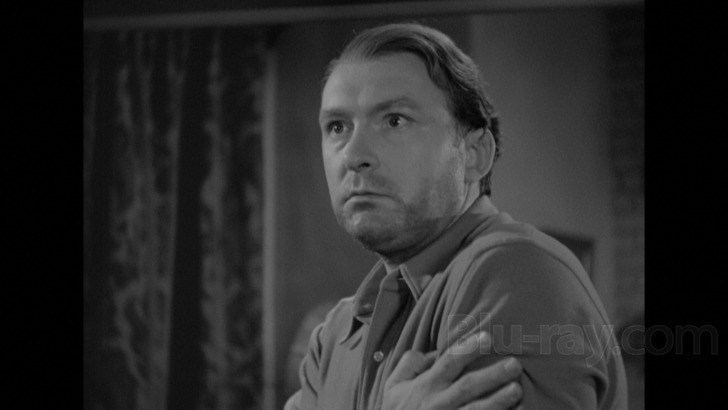
One of the issues facing Farmer was the lack of substantial roles being offered to her, and even though she had four film roles in 1941, only two of them really gave her much to do. Badlands of Dakota , as of the writing of this review the only other Farmer film available on Blu-ray (in a French edition which offers the main feature in a region free presentation), featured Farmer as Calamity Jane in a film which at one point was supposed to be called that character's name. Though released in 1942, Son of Fury: The Story of Benjamin Blake was actually shot in late 1941 and in a manner of speaking was at least an impressive swan song for Farmer's 1930s - 1940s Hollywood career, offering her an opportunity for some bristling scenes with Tyrone Power which crackle with considerable sexual intensity. Her other 1941 film in addition to the one currently under discussion was the screwball farce World Premiere, which probably gave Farmer at least a bit more of an acting exercise than her few scenes in Among the Living. What's kind of remarkable, then, is how much she is able to eke out of such a relatively minor role without the support of especially sharp writing for her character.
Farmer portrays Elaine Raden, wife of John (Albert Dekker), who has returned to the town the Raden family founded and specifically to the dilapidated, moss covered Raden family home to attend the funeral of John's father. Unbeknownst to either John or Elaine is the fact that John's identical twin brother Paul (Albert Dekker again), whom John had been led to believe died in childhood, is actually alive and has been locked away in the family mansion for decades after having suffered debilitating trauma in a dispute with his abusive father. Perhaps unsurprisingly, Paul is able to escape confinement just as John and Elaine arrive, and the town built up around the Raden family textile business suddenly has a madman running loose who looks an awful lot like one of the more upstanding (former) citizens of the community.
Among the Living was obviously not an A picture for Paramount, but it's an unusually gripping B, at least within the understanding that it definitely could have used a bit more development. That said, the film's very brevity tends to work in its favor at times, since things move along at such a breakneck pace that angst levels are sustained. Dekker is quite interesting in his dual lead, offering a staid and stolid John who contrasts memorably with the manic, unhinged but often rather childlike Paul. Hayward is a lot of fun as a flirtatious gal who obviously doesn't realize she's playing with fire when Paul starts rooming at her mother's boarding house. The film's strongest moments may be from Harry Carey, though, as a perhaps duplicitous doctor who has been taking care of the Radens for generations. Carey celebrated (according to varying press releases) his 50th anniversary in show business or his 33rd year in movies during the filming of this production, and one of those aforementioned publicity opportunities Farmer was uncharacteristically availing herself of in 1941 was attending a celebratory party for him, which resulted in another slew of Paramount photos.
Director Stuart Heisler and cinematographer Theodor Sparkuhl really invest the film with considerable luster, especially considering the kind of gritty, small town ambience the story exploits, which, along with the shambolic Raden mansion, gives things a definite Southern Gothic flavor. There are a number of really gorgeously shot moments that emphasize chiaroscuro, and one particular sequence featuring Paul chasing a hapless woman through dimly lit alleyways which verges on German Expressionism.
Among the Living Blu-ray Movie, Video Quality 
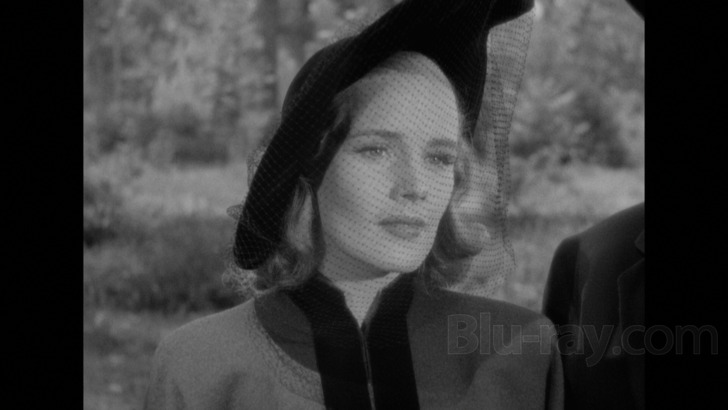
Among the Living is presented on Blu-ray courtesy of Kino Lorber with an AVC encoded 1080p transfer in 1.37:1. If you want to know how serious of a collector I am, this film was well nigh impossible to find in the pre-internet days, and I spent a really questionable amount of dough to get a copy, which was obviously sourced off of a 16mm dupe and was filled with scratches and splices galore. Suffice it to say, despite some manifest issues (discussed in a moment), this is a major step up and really offers substantial improvement from any other version of this film I've personally seen. There is still abundant damage to be spotted, including some fairly large scratches and nicks, but the most recurrent issue is slight frame instability and some noticeable warping. While contrast is generally secure, there are some very noticeable brightness fluctuations where blacks can kind of phase in and out of milky territory (pay attention to the first scene where Paul is introduced for one clear example). If you can get past those issues, this presentation is surprisingly strong for such a little known cult item. Detail levels on things like fabrics are typically very good to excellent. Grain resolves naturally throughout and I noticed no major compression issues.
Among the Living Blu-ray Movie, Audio Quality 
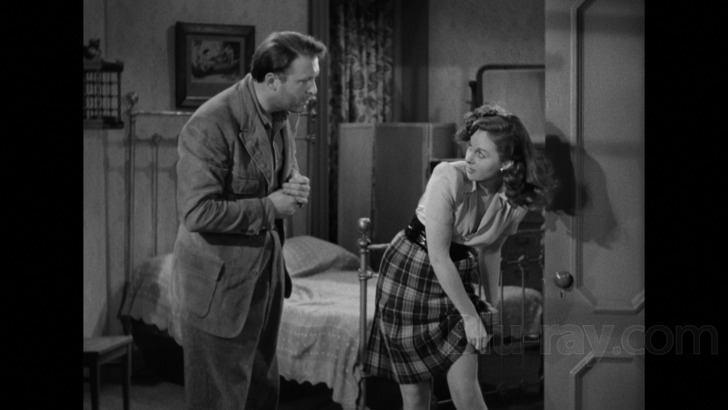
Among the Living features a DTS-HD Master Audio 2.0 Mono track that can't quite overcome the boxy sounding recording technologies of the day, which are probably exacerbated a bit by the condition of whatever element was utilized. Scoring can sound a bit brash and strident, but dialogue and effects are rendered without any major issues. Optional English subtitles are available.
Among the Living Blu-ray Movie, Special Features and Extras 
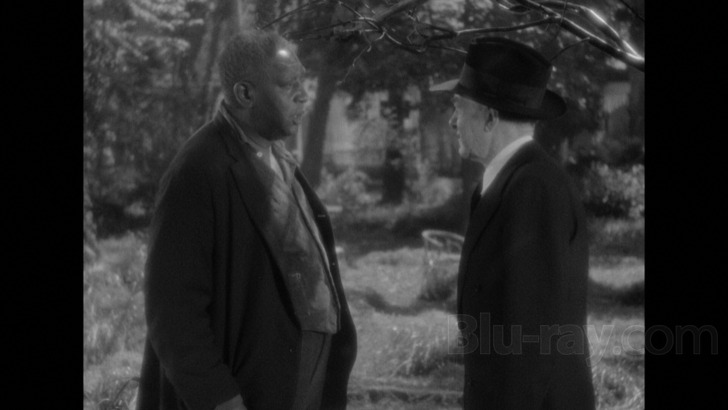
- Audio Commentary by Jason A. Ney provides a really interesting and thorough discussion of the film and some of its context. Ney discusses the state of Paramount during this production, as well as giving background information on the major players. In full disclosure mode, Dr. Ney also mentions me personally and my longstanding research into the real story of Frances Farmer, suggesting those interested read my piece "Shedding Light on Shadowland", which is easily findable via your favorite search engine.
Among the Living Blu-ray Movie, Overall Score and Recommendation 
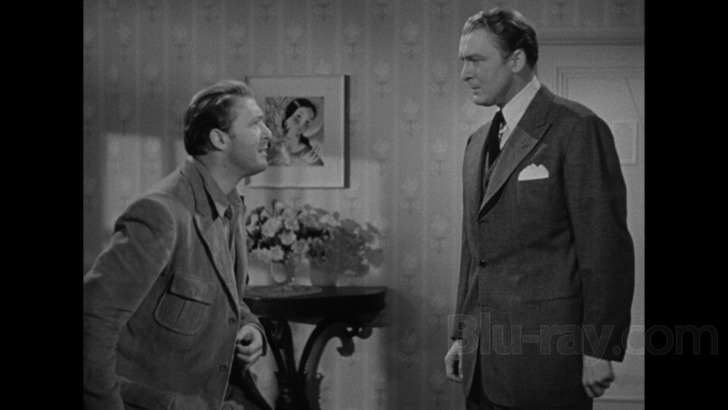
Among the Living generates considerable uneasiness as Paul starts marauding through the town of Raden, and Dekker makes the most of the opportunity to play two totally different characters (much as Farmer had done herself in 1936 in what many consider to be her best film, Come and Get It). The film is also notable for its very distinctive style, which should appeal to noir fans. Interestingly, the film was shot in the summer of 1941 and Variety reviewed it in September (mentioning how little Farmer had to do and how she was "wasted"), but for one reason or another it didn't receive wide release until just a few days after Pearl Harbor, which may have put the kibosh on big box office returns. It's been one of the more difficult cult films to get a decent copy of, and while this release has some issues in the video department in particular, it's head and shoulders above any other version I've personally seen. Recommended.
Similar titles
Similar titles you might also like

Alias Nick Beal
1949

The Man Between
1953

Street of Chance
The Black Curtain
1942

The Fearmakers
1958

Temptation
1946

The Window
Warner Archive Collection
1949

Night Has a Thousand Eyes
1948

Cause for Alarm!
1951

The Girl Hunters
Limited Edition of 2000
1963

Make Haste to Live
1954

The Woman in the Window
1944

Act of Violence
Warner Archive Collection
1948

Hustle
1975

Black Widow
Limited Edition to 3000
1954

Murder, My Sweet
Warner Archive Collection
1944

Sleep, My Love
1948

Portrait in Black
1960

The Blue Dahlia
1946

Leave Her to Heaven
1945

Possessed
Warner Archive Collection
1947
